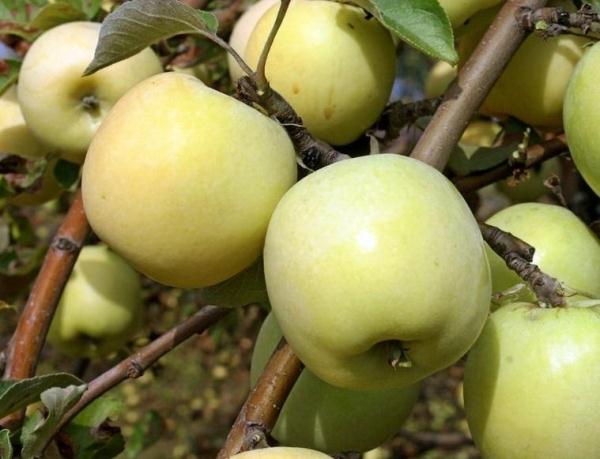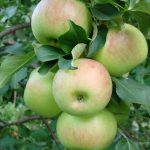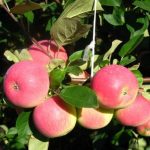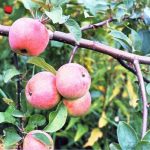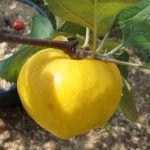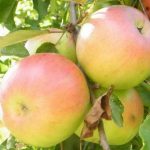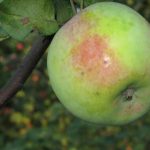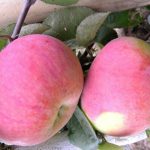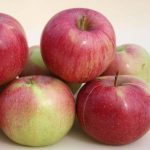The Antonovka apple variety has been one of the most common on the territory of Russia, Belarus, Ukraine for a long time. AND it owes its appearance for the most part not to breeders, but to gardener-lovers. It belongs to the category of national selection. With the description and reviews of gardeners about this variety, you can find below.
Table of contents
The history of the appearance of the variety
Despite its popularity, Antonovka belongs to those varieties, the occurrence of which is not exactly known. It is believed that she is random hybrid of a cultivar with a wild-growing forest apple tree.
It is believed that she came from the Kursk or Tula regions. This variety was first described in 1848 by N.I. Krasnoglazov in his work "Rules of fruit growing in open ground, greenhouses, greenhouses."
In 1896 S.V. Batov (living at that time in Tula) presented the Antonovka of Tula (in a different way, “The Spirit”) at the Nizhny Novgorod exhibition. According to him, the apple tree got its name Antonovka on behalf of gardener Anton, who for the first time brought it out in ancient times. And the name "brass" appeared because of the strong aroma ("spirit") of the fruit.
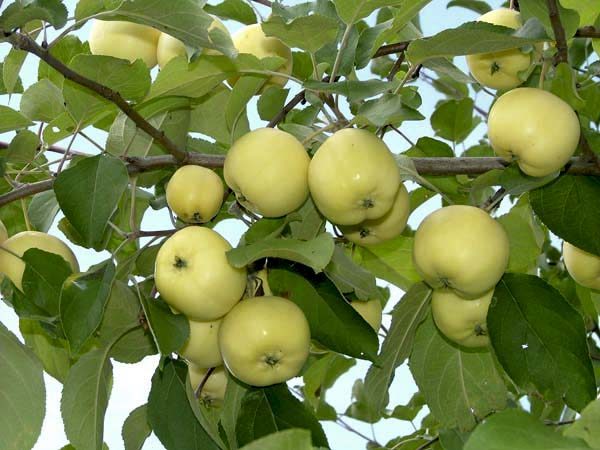
But at the same time, the Antonovka variety was not described in any of the registries A.T. Bolotov (there are only four), which contained more than 660 names of varieties of apple and pear. And in 1906 in his book “Atlas of the Fruits” A.S. Grebnitsky wrote that Antonovka was divorced for a very long time, but her place of origin is unknown.
To explain these two different facts, there is a theory that Antonovka in the registry Bolotov still was, but under a different name. In those days it was difficult to understand the varieties, there was confusion in their names. The same plant in different regions could be called differently. And Bolotov himself did not rule out such a probability.
As a separate variety Antonovka was allocated in the 19th century.. In the book "Russian apples" pomolog M.V. Rytov identified and described 17 varieties. And in 1929, I.V. Michurin mentioned 26 “varieties” of Antonovka. In 1981, in the publication of E.N. Sedov's "Catalog of Apple Varieties" emphasized that such a large number of varieties appeared due to the popularity of Antonovka among gardeners.
Antonovka varieties: gold, imrus, bogatyr and others
Currently based on Antonovka ordinary created 25 varieties. Among them are:
- Gold
- Imrus
- Bogatyr
- Memory of a warrior
- Cherry
- Orlov
- friendship of Peoples
- March.
- Bogatyr
- Cherry
- friendship of Peoples
- Gold
- Imrus
- March
- Orlov
- Memory of a warrior
Regions of apple
Today Antonovka can be found in the Moscow, Bryansk, Ryazan, Orel, Kursk, Varonezhsky, Penza, Kaluga, Tula regions of Russia, as well as in Ukraine and Belarus.
Some varieties are grown even in the Altai, Urals, Siberia and the Far East.
Tree description
Antonovka tree is a vigorous, with an oval crown. Over time, it becomes spherical and sprawling. The main branches rise and over the years expand to the sides. This process begins simultaneously with fruiting. Branches and young shoots are covered with brown bark.

The leaves are bright green, oblong, serrated at the edges. During flowering inflorescences are large, white or pink tinged.
Fruiting
Antonovka belongs to early winter or late autumn varieties. Usually the fruits begin to collect in the second half of September.. Antonovka Ordinary refers to the most fruitful trees. The tree begins to bear fruit after 7-8 years (after budding). On dwarf rootstocks, the first crop can be harvested already 2 years after disembarkation.
The fruits of Antonovka ordinary large with a rounded shape. In the lower part of the ribs are strongly pronounced. In the period of ripening have a green color with a yellow tinge. During storage completely yellow.The flesh itself is light, sweet, with a pronounced sour taste.

Antonovka gold for ripening can be attributed even to summer varieties. Her fruits are sweet and softer. Individual apples can reach a weight of 160 grams. And they begin to collect in the horse of August.
Productivity and terms of fruit picking
The number of apples increases as the tree grows. Up to 200 kilograms of fruit can be harvested from a twenty-year-old tree. (200 kg / ha). There were cases when from one tree Antonovka collected up to 500-1000 kilograms of apples. At first, fruiting is regular. But over time, it becomes periodic (once every two years).
Antonovka fruits ripen by the end of September - October. The main subtlety is to collect apples before the first frost, and they ripen in a cool place. Apples are ready to be harvested when a yellowish tint appears on their color, but the texture is still dense.
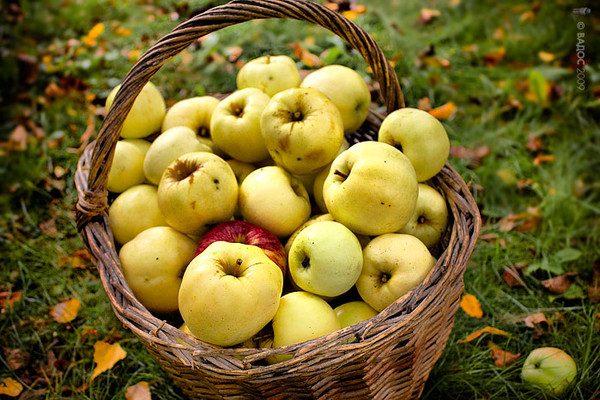
To keep the fruits longer, they must be picked by hand.. If you shake the tree, the apples will fall and beat on the ground. And in these places in the future will begin to deteriorate.Gather the fruits in wooden boxes or baskets, and plastic buckets will do.
Apple storage
Three times the value of the variety - the duration of storagewhich term reaches 3 months. With proper care and treatment, this period may increase to 4 months.
The peculiarity is that the storage time depends on the region of growth. For example, apples collected in the northern regions are easily stored for four months. And over time, their taste only improves. But the fruits from the southern regions deteriorate faster.
The advantages and disadvantages of the variety
Among the main advantages of Antonovka are the following:
- Good adaptability to different regions
- High yield
- Disease resistance and frosts
- High fruit marketability
- Unique taste and aroma
- Apples can be consumed fresh, soaked and after processing
- The fruits have a number of beneficial properties. are good antioxidants.
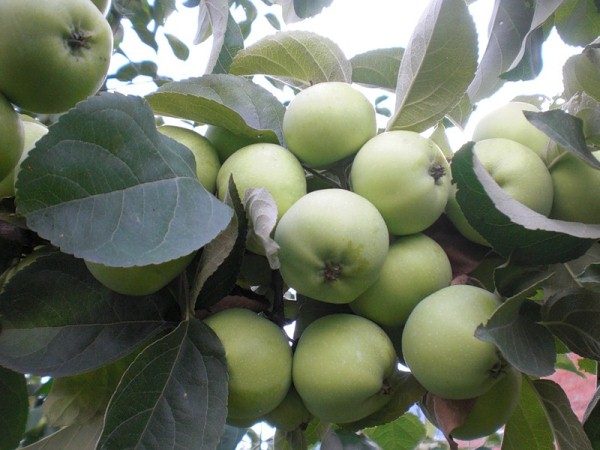
Like all plants, Antonovka has its drawbacks:
- Fruiting is periodic
- Fruits are not all varieties stored for a long time.
Pollination
Antonovka is a self-infested tree, that is, it needs pollinators. Best suited for this purpose:
- Saffron Pepin
- Welsey
- Autumn striped
- Anise.
Landing
In the greater territory of Russia, Antonovka is planted until the end of October.. Planted later plants may not have time to settle down. If spring planting is planned, then the best time for it is the end of April. In this case, the place for the seedling is better to prepare in the fall.
The hole is prepared with a size of approximately 1 meter in diameter and up to 80 cm in depth. This is done a few weeks before landing. This will help the seedling to take root more easily, so that the tree will start to bear fruit earlier.
During planting, the sod is laid on the bottom of the pit and it is well watered. A peg is inserted whose length is above the level of the soil. A fertile layer of soil with fertilizers (mineral and organic) up to 20 cm high is poured on top. Then the seedling is lowered and covered with earth.At the same time you need to be careful with the roots, so as not to damage them. To get all the nutrients to the roots, remove all the leaves from the seedling.
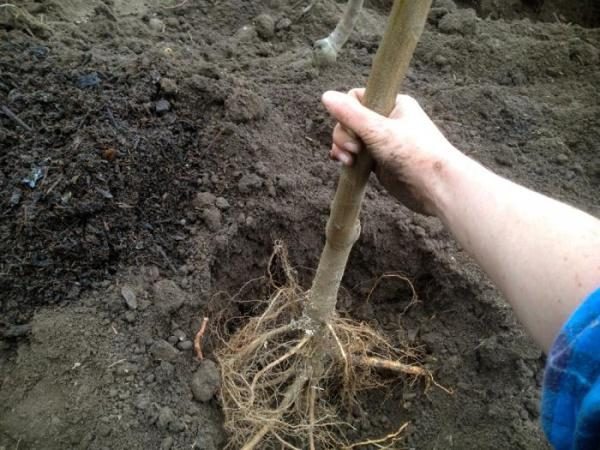
Under no circumstances should the root neck be buried. When the seedling is almost completely filled, it is necessary to pull it up a little. Due to this, the root neck will rise slightly above the ground level, and there will be no air between the roots. Seedling tied to a peg. Next, the soil is abundantly watered, mulched. In the first month or two watered weekly.
Antonovka saplings are planted at a distance of more than 1 meter from each other.
Care
Antonovka grows well even in scarce lands, where gardening problems usually arise. But naturally, they need the right care.
After heavy rainfall, the soil near the tree needs to be aerated.. This can be done with ordinary forks or with a metal bar, simply piercing the ground to a depth of 30 cm. During a period of drought and high temperatures, Antonovka should be watered abundantly once a week.
In the first year of life, seedlings are especially important the right care. It includes some simple steps:
- Top dressing fertilizer
- Protection from diseases and pests
- Soil loosening pristvolny circle and removal of weeds
- Timely watering
- Correct trimming.
Another important process is mulching. For more mature plants, it is possible to sow the tree trunk with green manure.
Fertilization
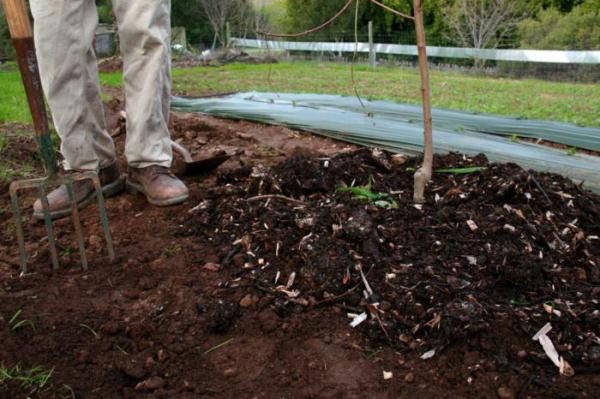
For better fruiting, the apple tree should be fed 4 times a year:
- 1 top dressing. In the spring, before flowering, Antonovka is fed with urea in the amount of 50-500 g, depending on the size and age of the tree. Fertilizers are spread on the soil under the crown of the tree.
- 2 dressing. With the advent of flowers, potash and phosphate fertilizers, slurry and urea are applied.
- 3 dressing is carried out by nitrogen fertilizers during the ripening of fruits.
- 4 dressing after harvesting. Bring potassium and phosphorus.
Cropping and crown formation

Simultaneously with dressing In the spring you need to trim the crown. Do it a couple of weeks before the growing season.At the same time, dry and damaged branches, wild shoots are harvested, thinning the crown.
Protection against diseases and pests
Antonovka, like all plants, requires protection from pests and diseases.
To do this, use karbofos 0.1% or rovikurt 0.1%. A little later, when the kidneys appear, use Bordeaux liquid 3%. Her, only in a concentration of 1% is used to combat diseases during the shedding of petals. With the same purpose, copper oxychloride 0.4% is also used. All treatments with pesticides are best carried out in the evening, before sunset. Night treatment is allowed if there is no dew. Fallen leaves are harvested and burned.
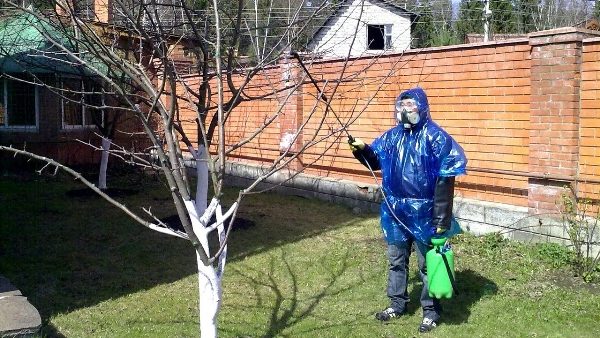
Caterpillars and weevils appearing on trees are harvested by hand and destroyed. Wasp-riders will help from insect pests. Umbrella plants (for example, dill), planted near the apple tree, will help to attract them to the tree.
Unique taste and aroma, resistance to frost, long shelf life - these are the main characteristics that attract gardeners. Despite the emergence of new breeding varieties of apples, Antonovka still remains one of the most popular and favorite varieties.
